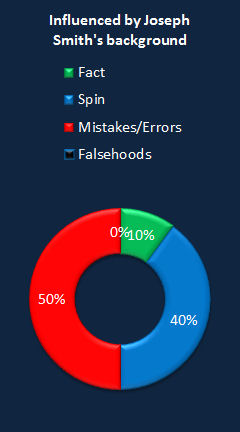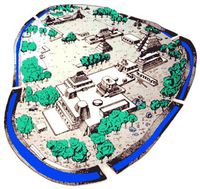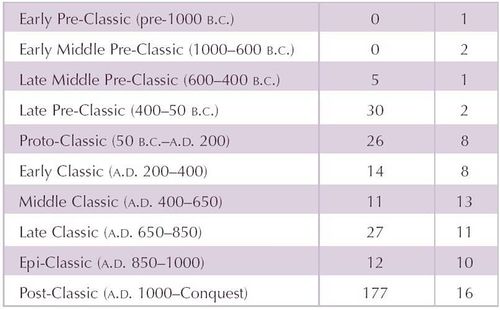
FAIR is a non-profit organization dedicated to providing well-documented answers to criticisms of the doctrine, practice, and history of The Church of Jesus Christ of Latter-day Saints.
FAIR Answers—back to home page
| Prophecies in the Book of Mormon | A FAIR Analysis of: Difficult Questions for Mormons, a work by author: The Interactive Bible
|
Influenced by the KJV of the Bible |
| Claim Evaluation |
| Difficult Questions for Mormons |

|
Response to claim: "Why are themes of the revolutionary war and patriotism (liberty, freedom, country, religion, flags, etc.) woven throughout a book supposedly written over a thousand years before the revolutionary war?"
Response to claim: "Why is an agrarian society similar to the society Joseph was most familiar with described as the setting for the entire book?"
Response to claim: "Why is a democracy after a monarchy described? (Mosiah 23, 29) - As happened in the history of the U.S."
Response to claim: "Is it purely coincidental that there was much speculation in Joseph Smith's area about Indian Mounds and battles?"
Joseph Smith himself initially believed that the presence of the mounds supported the story related in the Book of Mormon. In fact, as Zion's Camp passed through southern Illinois, Heber C. Kimball and several other participants claimed that Joseph identified a set of bones discovered in one of these mounds as "Zelph", a "white Lamanite." In a letter that Joseph wrote to Emma the day after this discovery, he stated:
The whole of our journey, in the midst of so large a company of social honest and sincere men, wandering over the plains of the Nephites, recounting occasionally the history of the Book of Mormon, roving over the mounds of that once beloved people of the Lord, picking up their skulls & their bones, as a proof of its divine authenticity, and gazing upon a country the fertility, the splendour and the goodness so indescribable, all serves to pass away time unnoticed.[1]
Joseph felt that the presence of the mounds in North America and ruined cities in Central America supported the Book of Mormon. Since information about the ruined cities in Central America came to light after the publication of the Book of Mormon, it actually strengthens the theories and evidences which place the Book of Mormon in a Mesoamerican setting--Joseph was willing to consider a setting of which he apparently had no previous knowledge. The description of the ancestors of the American Indians as a highly civilized culture capable of building great cities was not a concept which would have been deduced from the contemporary beliefs regarding the Mound Builders.
The presence of numerous burial mounds in the eastern United States was the source of great speculation to those that settled there. The construction of such mounds was not considered to be within the ability of the Native Americans, who were considered to be savages. It was assumed that such sophisticated constructions constituted evidence of a long lost, highly civilized society which had long since vanished. Some even postulated the existence of separate civilized and a savage societies, with the highly civilized group eventually being destroyed by the savage one. After years of research, however, it was concluded that the mounds had indeed been constructed by the ancestors of the Indians that continued to live in the area.
Joseph clearly believed not only the region of the mounds to be part of Book of Mormon lands, but the entire continent, including Central America. The Book of Mormon itself, however, makes no mention of mounds.
In 1841, the Times and Seasons, of which Joseph was the editor at the time, commented on a popular book by John Lloyd Stephens called Incidents of travel in Central America, Chiapas and Yucatan. This book described amazing ruined cities that had been found in Central America.
Joseph Smith himself, as editor of the Times and Seasons wrote and signed (as "ED[itor]") the following on July 15, 1842. Notice that he mentions both the mounds and the ruins in Guatemala as supporting the Book of Mormon:
If men, in their researches into the history of this country, in noticing the mounds, fortifications, statues, architecture, implements of war, of husbandry, and ornaments of silver, brass, &c.-were to examine the Book of Mormon, their conjectures would be removed, and their opinions altered; uncertainty and doubt would be changed into certainty and facts; and they would find that those things that they are anxiously prying into were matters of history, unfolded in that book. They would find their conjectures were more than realized-that a great and a mighty people had inhabited this continent-that the arts sciences and religion, had prevailed to a very great extent, and that there was as great and mighty cities on this continent as on the continent of Asia. Babylon, Ninevah, nor any of the ruins of the Levant could boast of more perfect sculpture, better architectural designs, and more imperishable ruins, than what are found on this continent. Stephens and Catherwood's researches in Central America abundantly testify of this thing. The stupendous ruins, the elegant sculpture, and the magnificence of the ruins of Guatamala [Guatemala], and other cities, corroborate this statement, and show that a great and mighty people-men of great minds, clear intellect, bright genius, and comprehensive designs inhabited this continent. Their ruins speak of their greatness; the Book of Mormen [Mormon} unfolds their history.-ED.[2]
A later Times and Seasons article, published on October 1, 1842 under Joseph's editorial supervision (though not signed by Joseph Smith as editor) stated:
It would not be a bad plan to compare Mr. Stephens' ruined cities with those in the Book of Mormon: Light cleaves to light and facts are supported by facts. The truth injures no one....[3]
One thing that critics do not consider is that if someone of that era were to attempt to write a book about a history of the North American Indians, he or she would not have written about advanced civilizations with advanced technology. The mysterious "Mound Builders" were not considered to be the ancestors of the current "savage" race that were inhabiting the land at that time.
Some of the witnesses of the Book of Mormon realized that there were going to be problems with this assumption after the publication of the Book of Mormon. In a interview, David Whitmer said:
When we [the Witnesses] were first told to publish our statement, we felt sure that the people would not believe it, for the Book told of a people who were refined and dwelt in large cities; but the Lord told us that He would make it known to the people, and people should discover evidence of the truth of what is written in the Book.[4]
Response to claim: "Why does the Book of Mormon describe wood forts with pickets to protect people--much like the forts of frontier?"
4 But behold, how great was their disappointment; for behold, the Nephites had dug up a ridge of earth round about them, which was so high that the Lamanites could not cast their stones and their arrows at them that they might take effect, neither could they come upon them save it was by their place of entrance. (Alma 49:4).
3 And it came to pass that after the Lamanites had finished burying their dead and also the dead of the Nephites, they were marched back into the land Bountiful; and Teancum, by the orders of Moroni, caused that they should commence laboring in digging a ditch round about the land, or the city, Bountiful. 4 And he caused that they should build a breastwork of timbers upon the inner bank of the ditch; and they cast up dirt out of the ditch against the breastwork of timbers; and thus they did cause the Lamanites to labor until they had encircled the city of Bountiful round about with a strong wall of timbers and earth, to an exceeding height. 5 And this city became an exceeding stronghold ever after; and in this city they did guard the prisoners of the Lamanites; yea, even within a wall which they had caused them to build with their own hands. Now Moroni was compelled to cause the Lamanites to labor, because it was easy to guard them while at their labor; and he desired all his forces when he should make an attack upon the Lamanites.(Alma 53:3-5).
The Book of Mormon's description of fortifications matches those in use in Mesoamerica. Multiple sites have been found; the city of Becan is well-known:
 The moat at Bécan in the Yucatan is 16 meters wide, and covers a distance of 2 kilometers. The enclosed city covers 25 hectares (almost 62 acres). Reconstruction, on-line at http://mayaruins.com/becan.html |
It should be noted too that the rise of Mesoamerican fortification in the archaeological record matches the introduction of this form of warfare among the Nephites by Captain Moroni in about 72 B.C. (See Alma 49:8).The first number indicates "Definitive" sites; the second is "Possible" sites:

Response to claim: "Is it purely coincidental that Lehi had six sons as did Joseph Smith Sr., Sam/Samuel were sons of both, and Nephi and Joseph Smith Jr. were so similar?"
Response to claim: "Why did Mormon, Nephi and other "heroes" of the Book of Mormon have so many common traits with Joseph Smith? (large in stature, had visions while a teenager, etc.—see "The Refiner's Fire" by John Brooke for many more similarities)"
Response to claim: "Why does the Book of Mormon repeatedly addresses 19th century readers?"
Response to claim: "Why is the anti-Masonic excitement that arose near Smith's home in 1827 reflected? (Gadianton Robbers / Secret Combos)"

Many have speculated that the supposed use of anti-Masonic language in the Book of Mormon is 'proof' of 19th century authorship. The authors of these speculations fail to take into account four critical issues which discredit the association between the Gadianton robbers of the Book of Mormon and the anti-Masonry of the opening decades of the 19th century [1826 through 1845].
Joseph Smith grew up with and was surrounded by Freemasons in his home. Both his father, Joseph Smith, Sr., and his elder brother Hyrum Smith were Masons in New York. It would seem unlikely that Joseph would be using anti-Masonic language and terms, given his family's close connection and association with the institution of Freemasonry.
In 1842, Joseph Smith, Jr., became a Mason. Had Joseph intended to tie the Gadianton robbers to the Freemasons, it seems most unlikely that only 12 years later he would then join the very group which the critics' theories require that he oppose so vehemently in the Book of Mormon.
To credit the critics' theories, wrote anti-Mormon Theodore Schroeder, we must accept that
when the Book of Mormon was finished, Smith's 'obsession' [with anti-Masonry] suddenly and permanently disappears without any other explanation, and Joseph Smith himself became a Mason, in spite of this anti-Masonic obsession.[5]
Any similarity between the language of the anti-Masonic movement and Joseph's translation can better be explained by Joseph using the language of his time and place rather than by a deliberate connection to anti-Masonry.[6]
Some have claimed that the phrase "secret combination" was used exclusively in a Masonic context in Joseph Smith's day. This is simply not the case, however. In 1788, during the debates at New York's state convention to ratify the federal constitution, Alexander Hamilton stated:
In this, the few must yield to the many; or, in other words, the particular must be sacrificed to the general interest. If the members of Congress are too dependent on the state legislatures, they will be eternally forming secret combinations from local views.[7]
And, in 1826, Andrew Jackson complained about Henry Clay's "secrete [sic] combinations of base slander."[8] Jackson was a prominent and well-known Mason, and his presidency was rich fodder for those who feared a Masonic conspiracy. Yet, despite the critics' claims that "secret combination" must refer only to Masons, a prominent Mason here complains about an attack on him in exactly those terms. Many other examples of the phrase being used in connection to other things besides masonry have been documented by Gregory L. Smith.[9]
“Some have seen evidence of anti-Masonic rhetoric in the Book of Mormon and cite 2 Nephi 26:22 in support of this theory, since Satan leads sinners ‘by the neck with a flaxen cord.’ It is claimed that this is a reference to Masonic initiation rituals, which feature a thick noose called a cable-tow or tow-rope. Examining the broader rhetorical context of 2 Nephi demonstrates that the ‘flaxen cord’ more likely refers to something slight and almost undetectable. To test this hypothesis, [Gregory L. Smith has undertaken] a survey of the use of the phrase flaxen cord in 19th century publications. [He] also [has] examine[d] analogous phrases from the Bible. [He] examine[d] fifty examples, seven of which are excluded [from his study done in Interpreter] because they do not contain enough information to support either claim. Of the remaining 43 examples, a full two-thirds (67%) describe a cord that is trivial or easily snapped. Only 7% denote a thick, strong rope, and 17% describe a thin rope that is strong. Given (1) the rhetorical context of 2 Nephi, (2) an expression that usually refers to a cord of trivial thickness and strength, and (3) virtually all poetic, scriptural, or allegorical uses imply fragility, the evidence overwhelmingly contradicts the anti-Masonic thesis.”[10]
Furthermore, the Saints of the 19th century saw the Book of Mormon's prophecies of latter-day "secret combinations" fulfilled by the persecution which they received at the hands of American citizens and the U.S. government. They did not invoke the Masons, which suggests that those who knew Joseph Smith did not recognize anti-Masonic themes in the Book of Mormon.[11]
The Book of Mormon has been explained by some as a product of Joseph Smith’s 19th century environment. Advocates of this thesis have argued that the phrase secret combinations is a reference to Freemasonry, and reflects Joseph’s preoccupation with this fraternity during the Book of Mormon’s composition in 1828–29. It is claimed that this phrase is rarely, if ever, used in a non-Masonic context during 1828–29, and that a type of “semantic narrowing” occurred which restricted the term to Freemasonry. Past studies have found a few counter-examples, which are reviewed, but none from during the precise years of interest. This study describes many newly-identified counterexamples, including: anti-Masonic authors who use the term to refer to non-Masonic groups, books translated in the United States, legislature bills, grand jury instructions, and works which so characterize slave rebellions, various historical groups and movements, Biblical figures, and religious groups. These examples are found before, during, and after the critical 1828–29 period. Examples from 1832 onward likewise demonstrate that no semantic shift occurred which restricted secret combination to Masonry. This element of the environmental hypothesis has now been robustly disproven.
Some have seen evidence of anti-Masonic rhetoric in the Book of Mormon and cite 2 Nephi 26:22 in support of this theory, since Satan leads sinners “by the neck with a flaxen cord.” It is claimed that this is a reference to Masonic initiation rituals, which feature a thick noose called a cable-tow or tow-rope. Examining the broader rhetorical context of 2 Nephi demonstrates that the “flaxen cord” more likely refers to something slight and almost undetectable. To test this hypothesis, I undertake a survey of the use of the phrase flaxen cord in 19th century publications. I also examine analogous phrases from the Bible. I examine fifty examples, seven of which are excluded because they do not contain enough information to support either claim. Of the remaining 43 examples, a full two-thirds (67%) describe a cord that is trivial or easily snapped. Only 7% denote a thick, strong rope, and 17% describe a thin rope that is strong. Given (1) the rhetorical context of 2 Nephi, (2) an expression that usually refers to a cord of trivial thickness and strength, and (3) virtually all poetic, scriptural, or allegorical uses imply fragility, the evidence overwhelmingly contradicts the anti-Masonic thesis.
Response to claim: "Why is infant baptism (a much discussed issue in the early 19th century) condemned in Chapter 8 of Moroni when it wasn't even an issue in the Bible?"
Notes

FAIR is a non-profit organization dedicated to providing well-documented answers to criticisms of the doctrine, practice, and history of The Church of Jesus Christ of Latter-day Saints.
We are a volunteer organization. We invite you to give back.
Donate Now